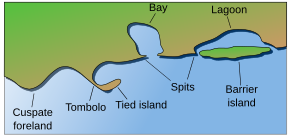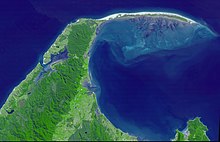Spit (landform)



Aspitorsandspitis adepositionbarorbeachlandform offcoastsor lake shores. It develops in places where re-entrance occurs, such as at a cove'sheadlands,by the process oflongshore driftby longshore currents. The drift occurs due to waves meeting the beach at an oblique angle, moving sediment down the beach in a zigzag pattern. This is complemented by longshore currents, which furthertransport sedimentthrough the water alongside the beach. These currents are caused by the same waves that cause the drift.[1][2][3]
Hydrology and geology
[edit]Where the direction of the shore inlandre-enters,or changes direction, for example at aheadland,the longshore current spreads out or dissipates. No longer able to carry the full load, much of the sediment is dropped. This is called deposition. This submerged bar of sediment allows longshore drift or littoral drift to continue to transport sediment in the direction the waves are breaking, forming an above-water spit. Without the complementary process of littoral drift, the bar would not build above the surface of the waves becoming a spit and would instead be leveled off underwater.
Spits occur whenlongshore driftreaches a section of headland where the turn is greater than 30 degrees. The spit will continue out into the sea until water pressure (e.g. from a river) becomes too great to allow the sand to deposit. Vegetation may then start to grow on the spit, and the spit may become stable and often fertile. A spit may be considered a special form of ashoal.As spits grow, the water behind them is sheltered from wind and waves, and asalt marshis likely to develop.

Waverefractioncan occur at the end of a spit, carrying sediment around the end to form a hook or recurved spit.[4]Refraction in multiple directions may create a complex spit. Waves that arrive in a direction other than obliquely along the spit will halt the growth of the spit, shorten it, or eventually destroy it entirely.[4]
The sediments that make up spits come from a variety of sources including rivers and eroding bluffs, and changes there can have a major effect on spits and other coastal landforms. Activities such as logging and farming upstream can increase the sediment load of rivers, which may hurt the intertidal environments around spits by smothering delicate habitats. Roads or bulkheads built along bluffs can drastically reduce the volume of sediment eroded, so that not enough material is being pushed along to maintain the spit.
If the supply of sediment is interrupted the sand at the neck (landward end) of the spit may be moved towards the head, eventually creating an island. If the supply is not interrupted, and the spit is not breached by the sea (or, if across an estuary, the river), the spit may become abar,with both ends joined to land, and form alagoonbehind the bar. If an island lies offshore near where the coast changes direction, and the spit continues to grow until it connects the island to the mainland, it is called atombolo.
The end of a spit attached to land is called the proximal end, and the end jutting out into water is called the distal end.
Notable spits around the world
[edit]
There is debate as to the longest spit in the world, with both theArabat Spitin theSea of Azovand theYounghusband PeninsulainSouth Australiaapproximately 110 kilometres (68 mi) long.[5][6][7]Alternatively, with the natural closing of the Roanoke inlet in 1811,Bodie IslandinNorth Carolinamay qualify as the longest, also measuring in at approximately 70 miles (110 km) to the peninsula's terminus at theOregon Inlet.[8]
The longest spit in a freshwater body of water isLong Point, Ontario,which extends approximately 32 km (20 mi) intoLake Erie.
Farewell SpitinNew Zealand,at 32 km (20 mi), in the north-west area ofSouth Island,is believed to be caused by the strong prevailing winds and currents, bringing sand eroded from theSouthern Alpsof the South Island and depositing these intoGolden Bay.
A well-known spit in the UK isSpurn Pointat theHumber;it is approximately 4.8 km (3.0 mi) long. Another isChesil Beachin the UK, which connects theIsle of Portlandto the mainland.
TheCuronian Spit,off the coast ofLithuaniaandKaliningrad OblastofRussia,separates theCuronian Lagoonfrom theBaltic Sea;it is 98 km long (61 mi). In a similar fashion, theVistula Spitseparates theVistula Lagoonfrom theGdańsk Bayoff the coast ofPoland.
Zlatni Rat,a popular pebble beach jutting southward from the harbor town ofBol,on the Croatian island ofBrač,is formed byAdriaticcurrents flowing east and west through theHvar Channel,along the southern side of the island. The spit bends slightly west or east, changing its direction gradually, depending on the conditions of the tides and weather.
Human settlement patterns
[edit]Since prehistory humans have chosen certain spit formations as sites for human habitation. In some cases, these sites have been chosen for proximity to marineresource exploitation;theChumashNative Americanprehistorical settlement on theMorro Bayis one such location.[9]
See also
[edit]- Barrier island
- Isthmus
- List of geographical spits
- Ria,often confused with spit
- Shoal,a related landform
- Strait,the sea equivalent of an isthmus
- Tombolo
References
[edit]- ^Duane, D.B. and James, W.R., 1980, "Littoral transport in the surf zone elucidated by an Eulerian sediment tracer experiment:"Journal of Sedimentary Petrology.vol. 50, p. 929-942
- ^Allen, James R. (1982). "Spits".Beaches and Coastal Geology.Encyclopedia of Earth Sciences Series. pp. 789–792.doi:10.1007/0-387-30843-1_432.ISBN978-0-87933-213-6.
- ^Uda, Takaaki (2019)."Spits".Encyclopedia of Coastal Science.Encyclopedia of Earth Sciences Series. pp. 1623–1627.doi:10.1007/978-3-319-93806-6_297.ISBN978-3-319-93805-9.
- ^abEvans, O.F. 1942, "The origin of spits, bars and related structures:"Journal of Geology,v. 50, p. 846-863
- ^Kazancı, Nizamettin; Gürbüz, Esra; Özgüneylioğlu, Aysen; Gürbüz, Alper; Boyraz-Aslan, Sonay; Erturaç, M. Korhan; Günok, Emine; Yücel, T. Onur; Yedek, Özgür (1 September 2022). "An inventory of coastal spits of the eastern Mediterranean and Black seas".Mediterranean Geoscience Reviews.4(3): 329–349.
- ^Bourman, Robert; Harvey, Nick; James, Kris (2006). "Evolution of the Younghusband Peninsula".South Australian Geographical Journal(105): 37–50.
- ^Brookes, Justin; Aldridge, Kane; Hipsey, Matthew; Busch, Brendan; Ye, Qifeng; Gibbs, Matt; Paton, David (1 January 2021). "Chapter 5 - Ecological condition of the Lower Lakes and Coorong".Murray-Darling Basin, Australia.1:95–108.doi:10.1016/B978-0-12-818152-2.00005-X.ISBN9780128181522.S2CID229395900.
- ^"Currituck Banks Reserve".deq.nc.gov.North Carolina Department of Environmental Quality.Retrieved20 June2023.
- ^Hogan, C. Michael (December 2012). Burnham, A. (ed.)."Morro Creek".The Megalithic Portal.


